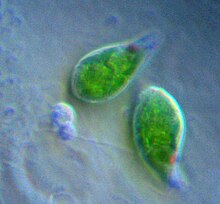Euglenozoa
| Euglenozoa | |
|---|---|
 |
|
| Two Euglena | |
| Scientific classification | |
| Domain: | Eukaryota |
| (unranked): | Excavata |
| Phylum: |
Euglenozoa Cavalier-Smith, 1981 |
| Classes and unplaced genera | |
|
Diplonemea |
|
| Synonyms | |
|
|
Diplonemea
Euglenoidea
Kinetoplastea
Symbiontida
Postgaardi
Calkinsia
The Euglenozoa are a large group of flagellate excavates. They include a variety of common free-living species, as well as a few important parasites, some of which infect humans. There are two main subgroups, the euglenids and kinetoplastids. Euglenozoa are unicellular, mostly around 15-40 µm in size, although some euglenids get up to 500 µm long.
Most euglenozoa have two flagella, which are inserted parallel to one another in an apical or subapical pocket. In some these are associated with a cytostome or mouth, used to ingest bacteria or other small organisms. This is supported by one of three sets of microtubules that arise from the flagellar bases; the other two support the dorsal and ventral surfaces of the cell.
Some other euglenozoa feed through absorption, and many euglenids possess chloroplasts and so obtain energy through photosynthesis. These chloroplasts are surrounded by three membranes and contain chlorophylls A and B, along with other pigments, so are probably derived from a captured green alga. Reproduction occurs exclusively through cell division. During mitosis, the nuclear membrane remains intact, and the spindle microtubules form inside of it.
The group is characterized by the ultrastructure of the flagella. In addition to the normal supporting microtubules or axoneme, each contains a rod (called paraxonemal), which has a tubular structure in one flagellum and a latticed structure in the other. Based on this, two smaller groups have been included here: the diplonemids and Postgaardi.
...
Wikipedia
